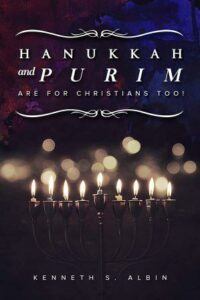(Updated for 2025)
The Festival of Purim is traditionally celebrated on 14 Adar, in the last Biblical month. In leap years when Adar II is added, Purim traditionally begins on 14 Adar II. For the Gregorian year 2025 it is Friday, March 14. More accurately, with the day beginning at sundown this holiday actually begins on Thursday evening, March 13, and lasts until the end of daylight on Friday, March 14. Many Jewish congregations will celebrate for two days.
Purim isn’t one of the Appointed Times, or moedim, described in the Torah. The celebration of Purim came about in the 4th century BCE. The exact date is uncertain because the identity of the Persian king Ahasuerus (in Hebrew, Artaxerxes in Greek) is debated. In the Hebrew Bible it is described only in the book of Esther and is not mentioned in the New Testament.
But I’m Not Jewish
Why would someone who isn’t Jewish celebrate a Jewish holiday? Well, the bottom line is, it is fun. And it really isn’t that unusual. Many non-Mexican people participate in and enjoy Cinco de Mayo, and just a week after Purim a whole lot of non-Irish folks will celebrate Saint Patrick’s Day.
Like Hanukkah, Purim was added to the Jewish calendar long after the Feasts of Yahweh, the Appointed Times, were established. You won’t find them listed among the moedim in Leviticus 23, or anywhere in the Torah for that matter. Unlike Hanukkah, which is not even mentioned in the Tanakh (the Hebrew Bible, the Christian Old Testament), Purim and the drama leading up to it is described in detail in the book of Esther. Also unlike Hanukkah, acknowledged in the book of John, the Festival of Purim is not found anywhere in the New Testament.
Historical Events
The events leading up to Purim take place in the land of Persia, in the city of Susa/Shushan in what is now western Iran. This story takes place sometime after the 70-year Babylonian captivity but probably before Ezra the priest and Nehemiah the governor returned to the land of Israel. Through a series of divinely orchestrated events, a young Jewish girl named Hadassah, now known as Esther, becomes the wife of the king. Meanwhile the Kings right-hand man, Haman, has developed a scheme to exterminate all the Jews. Through casting lots (Hebrew, purim), something similar to rolling dice, a date of 13 Adar is chosen to carry out the mass execution (Esther 3:13). But before it can happen, Esther, with the encouragement of her cousin Mordecai, reveals her heritage to the king, Haman is hanged, and the Jews are saved.
There are, of course, a few more details than just my brief summary. You can read them in the Bible in the book of Esther, which happens to be a tradition during Purim. There is even more to the story written in the Greek version of Esther found in the Apocrypha (from the Septuagint), including the content of letters and prayers.
Then Mordecai recorded these events, and he sent letters to all the Jews who were in all the provinces of King Ahasuerus, both near and far, obliging them to celebrate the fourteenth day of the month Adar, and the fifteenth day of the same month, annually, because on those days the Jews rid themselves of their enemies, and it was a month which was turned for them from sorrow into gladness and from mourning into a holiday; that they should make them days of feasting and rejoicing and sending portions of food to one another and gifts to the poor (Esther 9:20-22).
For Haman the son of Hammedatha, the Agagite, the adversary of all the Jews, had schemed against the Jews to destroy them and had cast Pur, that is the lot, to disturb them and destroy them. …Therefore they called these days Purim after the name of Pur.
(Esther 9:24,26)
Traditional Jewish Celebrations
The observance of Purim actually begins before the holiday on the anniversary of the proposed execution date, 13 Adar. This day is set aside for fasting, in remembrance of the three-day fast among the Jews before Esther went in to begin her process of informing the king of the treacherous plot.
The fast is followed by a time of partying the next day. As I write this, it is “Fat Tuesday” on the Christian calendar and I am seeing irony in the situation. I see the Mardi Gras revelry on the news as people indulge in sinful activity, only to observe “Ash Wednesday” and (at least appear to) repent the next day. In contrast, Jewish people will fast on 13 Adar to remember their utter helplessness as they call upon God for deliverance, and then enter into joyful celebration of that deliverance the following day.
The typical Jewish celebration includes the three things mentioned in the book of Esther: Feasting, merrymaking, and charity to the poor. The feasting and merrymaking is done with a meal during the daylight hours called seudah, a banquet to recognized the banquet with King Ahasuerus, Queen Esther, and Haman. It includes a fair amount of wine. In merrymaking, according to one Jewish source, “you are not supposed to get rip-roaring drunk, only happily tipsy.” It is tradition to read the story from the megillah, or scroll, of Esther. While doing so, participants sometime dress in costume, act out parts of the story, and “boo” Haman while they cheer for Mordecai. If you are familiar with the antics associated with Rocky Horror Picture Show, well, you get the idea.
Messianic Observance
Purim is a distinctly Jewish holiday. As believers in Messiah, we understand that the Gospel message “is the power of God for salvation to everyone who believes, to the Jew first and also to the Greek” (Romans 1:16). Yeshua himself said that “salvation is from the Jews” (John 4:22). We must recognize that it is God’s continued protection and deliverance of the Jewish people that has made it possible for all of us, regardless of our ethnic heritage, to enter into covenant with the Creator through Yeshua, the Jewish Messiah.
Purim is an opportune time for believers in Messiah Yeshua to offer praise and thanksgiving to the One who watches over Israel and does not slumber or sleep (Psalm 121:4).
Pray for the peace of Jerusalem:
“May they prosper who love you.
“May peace be within your walls,
And prosperity within your palaces.”
(Psalms 122:6-7)
For a fun family experience, you might want to watch the Veggie Tales movie, “Esther, the Girl Who Became Queen.” Gather everyone around and “boo” at Haman and cheer for Mordecai as the Veggie Tales cast puts a unique spin on this story. Enjoy some special shortbread cookies called Hamantashen while you watch the movie (the recipe is listed below). The word means “Haman’s Pockets” and reminds us of the money Haman paid in his attempt to have the Jews murdered. Devour them with a glass of milk so they aren’t around anymore!
Purim Blessings
Shehecheyanu – Traditional Festival Blessing:
Taken from the Prayer Book and Life Cycle Guide for Messianic Believers in Yeshua.
ShehecheyanuBaruch atah Adonai Eloheinu, melech ha-olam
Shehecheyanu v’kiy’manu v’higiyanu laz’man hazeh
Blessed are you, Oh Lord our God, king of the universe
Who has granted us life, and sustained us, and brought us to this season
Reading of the Meghillah (Scroll):
Adapted from The Complete Artscroll Siddur.
PurimBaruch atah Adonai Eloheinu, melech ha-olam
Harov et riveinu, v’hadan et dineinu, v’hanakeim
niq’maseinu, v’ham’shalem g’mul l’kol oy-vey
nafsheinu, v’hanifra lanu mitzreinu. Baruch atah
Adonai, hanifra l’amo yisrael mi-kol
tzareihem, ha-El ha-moshia
Blessed are you, Oh Lord our God, king of the universe,
Who takes up our grievance, judges our claim, avenges
our wrong; who brings just retribution upon all enemies
of our soul, and exacts vengeance for us from our foes.
Blessed are you Adonai, who exacts vengeance for his
people Israel from all their foes, the God Who brings salvation.
Recipes
Hamantashen (Haman’s pockets)

This recipe is adapted from the book God’s Appointed Times.
Ingredients:
1 cup butter or margarine
1 cup sugar
2 egg yolks
1/4 teaspoon vanilla
1/2 teaspoon salt
3 cups flour
1 teaspoon baking powder
1/3 cup milk
Filling (see below, or just use apricot or other thick fruit preserves)
Directions:
Cream butter, sugar, yolks and vanilla. Mix in the dry ingredients and milk. Divide recipe in two and refrigerate several hours or overnight. After dough is chilled, roll on floured board until 1/8-inch thick. Cut into 3-inch circles using a cup or cookie cutter. Place on parchment paper on cookie sheet. Put a small amount of filling in each center. Fold 3 sides up to form a triangle and pinch the corners to make a point. Bake at 350 degrees for 8-10 minutes.
Apricot-Cheese Filling:
Mix together 8 oz cream cheese (softened), 4 oz finely chopped dried apricots, and sugar to taste.
Additional Posts About Purim
Purim – Esther and the Decree of the King
Questions on the Book of Esther
Unless marked otherwise, Scripture quotations are from the New American Standard Bible (NASB) © The Lockman Foundation




